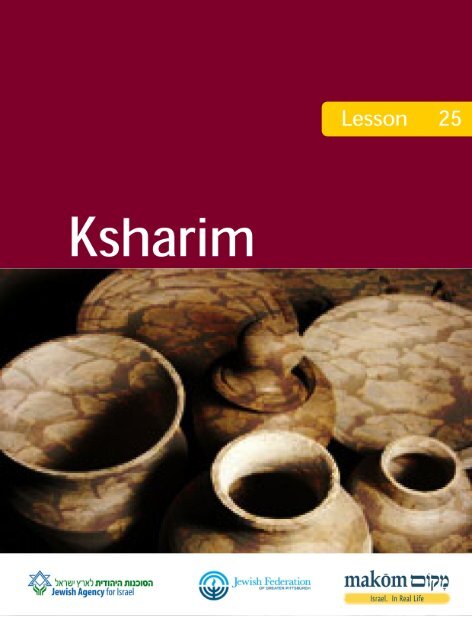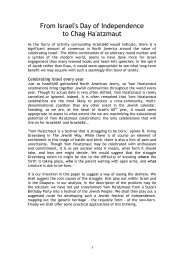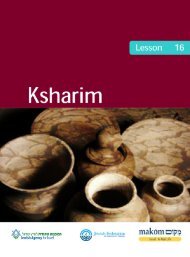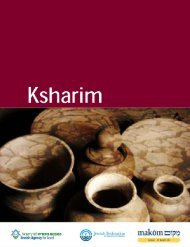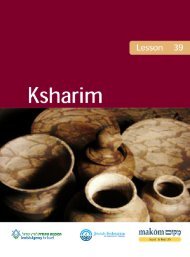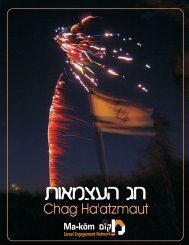Click here for printable pdf - Makom Israel
Click here for printable pdf - Makom Israel
Click here for printable pdf - Makom Israel
Create successful ePaper yourself
Turn your PDF publications into a flip-book with our unique Google optimized e-Paper software.
L e s s o n 25:<br />
High Holidays<br />
1. Outline<br />
a. <strong>Israel</strong> as a meeting place of different Jewish traditions (edot) - the various symbolic<br />
foods of Rosh Hashanah<br />
b. The Yom Kippur war<br />
c. Secular <strong>Israel</strong>is' connection to Jewish tradition<br />
2. Introduction<br />
a. Note: This lesson is divided into two unrelated sections, one quite light-hearted and<br />
the other very somber – it's up to the facilitator to decide on the order of the sections.<br />
b. Editor’s note: For the opening retreat of the Pittsburgh teachers’ course in September<br />
2004, texts were prepared <strong>for</strong> a brief sample lesson on the connection between the High<br />
Holy Days and <strong>Israel</strong>. This ended up being very brief, with the focus being the seder avoda<br />
(High Priest’s service on Yom Kippur)as a demonstration of the link between what we think<br />
of as a universalistic, “theological” holiday and a very specific reference to the map of <strong>Israel</strong><br />
– the route of the scapegoat from the Temple to the desert. These materials are appended<br />
<strong>here</strong>with, in case they might be useful: a midrash on the high priest’s entrance to the Holy<br />
of Holies on Yom Kippur; the seder avoda; links to sites showing squills ( chatzavim), the<br />
flower associated with the turning of the seasons in <strong>Israel</strong>, and two songs about Rosh<br />
Hashanah making reference to them.<br />
Symbolic foods: One of the striking things about <strong>Israel</strong> is the fact that although a majority<br />
of the citizens share their Jewish nationality, religion, ethnicity, culture and customs, their<br />
traditions are surprisingly different due to their diverse lands of origin. While in the initial<br />
years of the state, the declared goal was a melting pot in which all people would assimilate<br />
into one big Jewish-<strong>Israel</strong>i collective, in recent years the rich variation and diverse<br />
backgrounds have come to be appreciated, and ef<strong>for</strong>ts are made to celebrate and<br />
preserve the different ethnic cultures (or "edot", as they are called in Hebrew). In this lesson<br />
we will examine this issue by looking at the various symbolic foods eaten by the people of<br />
different edot on Rosh Hashanah.<br />
The Yom Kippur war: For <strong>Israel</strong>is, Yom Kippur, in addition to being the Day of Atonement,<br />
has taken on a new and somber meaning since the 1973 Yom Kippur war. The war was one<br />
of the bloodiest <strong>Israel</strong> has known, and <strong>for</strong> some it brought the euphoria and messianic<br />
fervor which emerged after the 1967 Six Day war to an abrupt halt. For a few days, <strong>Israel</strong>is<br />
felt unsure of their survival, personally and as a state; 3000 soldiers were killed – about 0.1<br />
percent of the population; the government considered using <strong>Israel</strong>'s atomic weapons to<br />
avert the catastrophe; the last-minute aerial shipment of arms and ammunition from the<br />
US helped <strong>Israel</strong> stem the tide. In the lesson we will watch and discuss a (30 min.) video<br />
about kibbutz Beit Hashita, which lost 11 of its members during the war. The kibbutz<br />
commissioned composer Yair Rosenblum to compose a new melody <strong>for</strong> the U'Netaneh<br />
Tokef prayer of Yom Kippur to commemorate the fallen soldiers. This melody is sung by<br />
chazzanim (cantors) in many <strong>Israel</strong>i synagogues today during Rosh Hashanah and Yom<br />
Kippur.<br />
213 Ksharim
3. Lesson goals<br />
a. "Taste" the complex web of ethnic traditions <strong>for</strong>med by the various edot in <strong>Israel</strong>.<br />
b. Experience the immense weight of meaning of the Yom Kippur war in <strong>Israel</strong>.<br />
c. Gain some understanding of the complex attitudes of secular <strong>Israel</strong>is towards Jewish<br />
tradition.<br />
4. Expanded outline<br />
Symbolic foods<br />
Take a look at the statistics describing the distribution of countries of origin of Jewish <strong>Israel</strong>is,<br />
supplied in the appendix below. A cursory glance will show that they're a very mixed bunch.<br />
This can be experienced in many occasions – we will show it by looking at the symbolic foods<br />
eaten by the different edot on the evening of Rosh Hashanah. Most people know the custom<br />
of eating apples dipped in honey as a sign <strong>for</strong> a good year, but t<strong>here</strong> many other traditions,<br />
and some people have a whole "seder" with different foods, each eaten after saying its own<br />
blessing.<br />
The custom of eating symbolic foods on Rosh Hashanah is mentioned in the Talmud:<br />
"Since t<strong>here</strong> is truth in signs, one should eat on Rosh Hashanah squash, green beans, leeks,<br />
beets and dates" (Babylonian Talmud, Kritut, 6a). Here are some explanations:<br />
A type of squash called "Kera," is phonetically related to the Hebrew word <strong>for</strong> "read" or<br />
"tear." We recite one or both of the following: "May You tear up our negative<br />
judgement," or "May You read our good merits be<strong>for</strong>e You."<br />
A type of green beans is called "Rubiyah," from the Hebrew word "to increase." We<br />
recite, "May our merits increase."<br />
Leeks, called "Karti" in Aramaic, is related to the Hebrew word "to cut." We recite, "May<br />
our misdeeds, our spiritual enemies, be cut down."<br />
Beets are called "Salka" in Aramaic, and in Hebrew, that word is related to removal. We<br />
recite, "May our enemies be removed."<br />
Dates are called "Tamri" in Aramaic which is related to the Hebrew word <strong>for</strong> consume.<br />
We ask <strong>here</strong> that those who want to destroy us be consumed.<br />
Today, in <strong>Israel</strong>, these vegetables are eaten on Rosh Hashanah by Sephardic Jews. Additional<br />
customs:<br />
Ashkenazi Jews eat carrots because of their Yiddish name "meren", which also means<br />
to increase. Carrots symbolize our hope that we increase our good deeds in the<br />
coming year.<br />
Sephardim prepare a challah shaped like a ladder - symbolizing our prayers <strong>for</strong> the<br />
new year going “up” directly to God, while Ashkenazim bake a round challah to<br />
symbolize the cycle of the year.<br />
Apples in honey are actually an Ashkenazi custom, while Yemenites eat pomegranate<br />
and wish that their good deeds in the coming year will be as numerous as the seeds of<br />
the pomegranate.<br />
In a similar vein, Iranian Jews eat a rice dish.<br />
Libyan Jews eat seven different fruits and vegetables and seven varieties of jam as a<br />
symbol of hope <strong>for</strong> abundance in the coming year<br />
Jews of Eastern European descent eat dishes with carrots, apples, raisins and honey.<br />
214 Ksharim
A cute activity you can try if you have time is to bring a few fruits and vegetables to the<br />
classroom and have the class try and invent New-Year-appropriate meanings <strong>for</strong> them, using<br />
wordplays, looking at their shape, color, etc. Here are a few examples from Noam Zion's Rosh<br />
Hashanah seder http://www.jafi.org.il/education/downloads/Rosh_HaShanah_seder.<strong>pdf</strong><br />
Dates - May it be God’s will that all my single friends have many dates this year.<br />
Tomatoes or Hot Peppers - May it be God’s will that this be a red-hot New Year.<br />
Celery - Let’s pray that our employers will raise our salary.<br />
Rabbi Yitz Greenberg suggested:<br />
Peaches – May we have a “peachy” year!<br />
Brussels Sprouts– May our good <strong>for</strong>tune “sprout”!<br />
(Irving Greenberg, High Holiday Guide [Clal,1977]).<br />
An interesting footnote: eating symbolic foods on the new year is not unique to Jews; see, <strong>for</strong><br />
example,<br />
http://www.bbc.co.uk/food/news_and_events/events_chinesenewyear.shtml<br />
http://allrecipes.com/advice/coll/all/articles/205P1.asp<br />
http://www.asiafood.org/persiancooking/newyear.cfm<br />
Yom Kippur war<br />
Read the words of the U'Netaneh Tokef prayer (see<br />
http://www.ou.org/chagim/roshhashannah/unetanehtext.htm <strong>for</strong> an English<br />
translation)<br />
Describe the prayer's background (see<br />
http://www.ou.org/chagim/roshhashannah/unetaneh.html)<br />
Briefly discuss the associations to judgment, martyrdom and death raised by the<br />
prayer and the legend.<br />
Supply the following background be<strong>for</strong>e showing the movie: Kibbutz Beit Hashita was<br />
founded in the Jezre'el valley in 1928, and now has about 1300 residents. In the Yom<br />
Kippur war 11 members of the kibbutz were killed in the fighting. The fallen soldiers<br />
were buried in temporary graveyards close to the battlegrounds until the war was<br />
over, then brought to their final graves in Beit Hashita at one mass funeral a few<br />
months after the war – scenes from this funeral are shown in the film.<br />
Beit Hashita is a typical kibbutz in that its founders were young, secular Jews, who<br />
severed themselves from Jewish religious tradition and replaced it with the Zionist,<br />
nationalist ethos. The kibbutzniks tried to infuse the ancient Jewish symbols with new<br />
meanings, connected to the land and the people. The Yom Kippur ceremony at the<br />
kibbutz be<strong>for</strong>e the war consisted of modern readings and music, and the only<br />
concession to tradition was the Memorial <strong>for</strong> the Souls (Azkarat neshamot, Yizkor).<br />
Watch the video.<br />
215 Ksharim
After the movie: The movie shows the process the kibbutz has gone through after the<br />
war, a process whose meaning is unclear to the kibbutz members themselves. Does<br />
the inclusion of the U'Netaneh Tokef prayer in the kibbutz Yom Kippur ceremony<br />
signify a return to Jewish tradition A search <strong>for</strong> the missing "areas of sanctity" in<br />
people's lives Harmless nostalgia An interpretation of the soldiers' sacrifice as<br />
another link in the chain of Kiddush Hashem (martyrdom), joining Rabbi Amnon of<br />
Mainz by sacrificing their lives <strong>for</strong> some higher ideal <strong>Israel</strong>i society in general is going<br />
through a similar process, so the facilitator should bring examples from <strong>Israel</strong>i society<br />
in general during the discussion of the story of the kibbutz.<br />
For a collection of articles exploring the impact of the Yom Kippur War on <strong>Israel</strong>i<br />
culture and consciousness, see:<br />
http://info.jpost.com/C003/Supplements/30YK/new.01.html<br />
The key concept in this process seems to be the conversion of Yom Kippur from a<br />
personal, theological/psychological day, when the individual stands be<strong>for</strong>e God in<br />
search of personal atonement, to a national day of soul searching, when the entire<br />
nation is bound together by the historical trauma of the Yom Kippur war. Thus, a day<br />
which had lost much of its meaning <strong>for</strong> secular <strong>Israel</strong>is (creating a dissonance between<br />
the cultural norm that this is the holiest of days and the reality that the day had<br />
become empty of content) took on new content and became emotionally powerful.<br />
216 Ksharim
Appendix – Jewish <strong>Israel</strong>is by country of origin 13<br />
Source: <strong>Israel</strong>i Bureau of Statistics, data from the 1995 census.<br />
Country of<br />
Origin<br />
Total<br />
<strong>Israel</strong><br />
Asia<br />
Africa<br />
Europe-<br />
Americas<br />
Total<br />
<strong>Israel</strong><br />
Place of birth<br />
Abroad <strong>Israel</strong><br />
Absolute numbers<br />
1,764,908 2,770,421<br />
Total<br />
- 1,155,014<br />
Total<br />
253,935 467,029<br />
Turkey<br />
34,685 50,861<br />
Iraq<br />
84,025 170,531<br />
Yemen<br />
41,453 111,306<br />
Iran<br />
53,644 76,734<br />
Other Asia<br />
40,128 57,597<br />
Total<br />
324,835 499,500<br />
Morrocco<br />
177,070 314,718<br />
Algier and<br />
Tunis<br />
44,549 77,831<br />
Libya<br />
21,629 51,111<br />
Egypt<br />
23,953 37,059<br />
Ethiopia<br />
46,134 13,087<br />
Other Africa<br />
11,500 5,694<br />
Total<br />
1,186,138 648,878<br />
Poland<br />
106,286 153,618<br />
Rumania<br />
143,217 117,839<br />
Bulgaria and<br />
Greece<br />
26,349 32,524<br />
Germany and<br />
Austria<br />
36,007 49,647<br />
Former USSR<br />
667,456 139,146<br />
Other Europe<br />
100,563 94,370<br />
North America<br />
and Oceania<br />
58,906 33,528<br />
Latin America<br />
47,354 28,206<br />
Percent<br />
100.0 100.0<br />
- 41.7<br />
Total<br />
4,535,329<br />
1,155,014<br />
720,964<br />
85,546<br />
254,556<br />
152,759<br />
130,378<br />
97,725<br />
824,335<br />
491,788<br />
122,380<br />
72,740<br />
61,012<br />
59,221<br />
17,194<br />
1,835,016<br />
259,904<br />
261,056<br />
58,873<br />
85,654<br />
806,602<br />
194,933<br />
92,434<br />
75,560<br />
100.0<br />
25.5<br />
13 Country of origin: country of birth, or (if born in <strong>Israel</strong>) country of parents' birth.<br />
217 Ksharim
Asia<br />
Africa<br />
Europe-<br />
Americas<br />
14.4<br />
18.4<br />
67.2<br />
16.9<br />
18.0<br />
23.4<br />
15.9<br />
18.2<br />
40.5<br />
Appendix: texts on <strong>Israel</strong> and the High Holy Days<br />
Kesharim<br />
Opening Retreat<br />
The Land of <strong>Israel</strong> and the High Holy Days – a few connections<br />
1. The center of the world:<br />
[Adapted from various midrashim by S. Anski, The Dybbuk, and then further adapted by The<br />
Jewish Catalogue]<br />
God’s world is great and holy. Among the holy lands is the world is the Holy Land of <strong>Israel</strong>. In<br />
the land of <strong>Israel</strong> the holiest city is Jerusalem. In Jerusalem the holiest place was the Temple,<br />
and in the Temple the holiest spot was the holy of holies.<br />
T<strong>here</strong> are seventy peoples in the world. Among these holy peoples is the people of <strong>Israel</strong>. The<br />
holiest of the people of <strong>Israel</strong> is the tribe of Levi. In the tribe of Levi the holiest are the priests.<br />
Among the priests, the holiest was the high priest.<br />
T<strong>here</strong> are 354 days in the year. Among these the holidays are holy. Higher than these is the<br />
holiness of the Sabbath. Among Sabbaths the holiest is the Day of Atonement, the Sabbath of<br />
Sabbaths.<br />
T<strong>here</strong> are seventy languages in the world. Among the holy languages is the holy language of<br />
Hebrew. Holier than all else in this language is the holy Torah, and in the Torah the holiest<br />
part is the Ten Commandments. In the Ten Commandments the holiest of all words is the<br />
name of God.<br />
And once during the year, at a certain hour, these four supreme sanctities of the world were<br />
joined with one another. That was on the Day of Atonement, when the high priest would<br />
enter the holy of holies and t<strong>here</strong> utter the Name of God…<br />
Every spot w<strong>here</strong> a man raises his eyes to heaven is a holy of holies. Every man, having been<br />
created by God in His own image and likeness, is a high priest. Every day of a man’s life is a<br />
Day of Atonement, and every word that a man speaks with sincerity is the Name of the Lord.<br />
2. The scapegoat: Yom Kippur and the geography of Jerusalem<br />
Carrying the sins of the people from the city into the desert<br />
Leviticus 16, and…<br />
Mishnah, Yoma, chapter 6<br />
218 Ksharim
He then came to the scapegoat and laid his two hands upon it and he made confession, and<br />
thus would he say: I beseech Thee O Lord, Thy people the house of <strong>Israel</strong> have failed,<br />
committed iniquity and transgressed be<strong>for</strong>e Thee. I beseech thee O Lord, atone the failures,<br />
the iniquities and the transgressions which Thy people, the house of <strong>Israel</strong> have failed,<br />
committed and transgressed be<strong>for</strong>e Thee, as it is written in the Torah of Moses, Thy servant, to<br />
say: “<strong>for</strong> on this day shall atonement be made <strong>for</strong> you, to cleanse you; from all your sins shall ye<br />
be clean be<strong>for</strong>e the Lord.” (Lev. 16:30)<br />
And when the priests and the people standing in the temple court heard the fully-pronounced<br />
name come <strong>for</strong>th from the mouth of the high priest, they bent their knees, bowed down, fell<br />
on their faces, and called out: Blessed be the name of His glorious kingdom <strong>for</strong> ever and ever.<br />
They handed it over to him who was to lead it away. All were permitted to lead it away, but<br />
the priests made it a definite rule not to permit an <strong>Israel</strong>ite to lead it away. R. Jose said: it once<br />
happened that Arsela of Sepphoris led it away, although he was an <strong>Israel</strong>ite.<br />
And they made a causeway <strong>for</strong> him because of the Babylonians who would pull its hair,<br />
shouting to it, “Take and go <strong>for</strong>th, take and go <strong>for</strong>th!”<br />
Some of the nobility of Jerusalem used to go with him up to the first booth. T<strong>here</strong> were ten<br />
booths from Jerusalem to the peak, a distance of ninety ris, seven and a half of which make a<br />
mil. At every booth they would say to him: <strong>here</strong> is food and <strong>here</strong> is water. They went with him<br />
from booth to booth, except the last one, <strong>for</strong> he would not go with him up to the peak, but<br />
stand from afar, and behold what he was doing.<br />
What did he do He divided the thread of crimson wool, and tied one half to the rock, the<br />
other half between its horns, and pushed it from behind, and it went rolling down and be<strong>for</strong>e<br />
it had reached half its way down hill it was dashed to pieces. He came back and sat down<br />
under the last booth until it grew dark.<br />
3. The link between nature in <strong>Israel</strong> and the religious calendar<br />
The chatzav – symbol of fall and the high holy day season:<br />
Pictures of chatzavim:<br />
http://www.botanic.co.il/a/picshowh.aspqcatnr=URGMAR&qseqnr=URGMAR1<br />
http://www.botanic.co.il/hebrew/research/chazav_files/chazav.jpg<br />
www.whitesquill.com/squillflowersinfield.jpg<br />
http://www.israelimages.com/files/15789.htm<br />
A Song <strong>for</strong> Tishrei<br />
Datya Ben Dor<br />
Between summer and fall –<br />
The month of Tishrei<br />
With everything we love<br />
In the month of Tishrei.<br />
שיר לחודש תשרי<br />
דתיה בן דור<br />
בין הקיץ לסתיו-<br />
חודש תשרי<br />
עם כל שנאהב<br />
בחודש תשרי.<br />
219 Ksharim
Apple and honey<br />
And apple on a flag<br />
And new clothes <strong>for</strong> the holidays.<br />
For we all know<br />
That the month of Tishrei<br />
Is a very festive month.<br />
Between summer and fall –<br />
The month of Tishrei<br />
With everything we love<br />
In the month of Tishrei.<br />
The chatzav of Tishrei,<br />
The sharav of Tishrei<br />
The first rain the dampens the schach.<br />
For we all know<br />
That the month of Tishrei<br />
Is a very changeable month.<br />
Between summer and fall –<br />
The month of Tishrei<br />
With everything we love<br />
In the month of Tishrei.<br />
Brachot of Tishrei<br />
Slichot of Tishrei<br />
And a silent prayer going up<br />
For we all know<br />
That in the month of Tishrei<br />
A new year begins <strong>for</strong> me.<br />
תפוח בדבש<br />
ותפוח על דגל<br />
ובגד חדש לחגים.<br />
כי ידוע הרי<br />
שחודש תשרי<br />
זהו חודש מאד חגיגי.<br />
בין הקיץ לסתיו-<br />
חודש תשרי<br />
עם כל שנאהב<br />
בחודש תשרי.<br />
חצב של תשרי,<br />
שרב של תשרי<br />
ויורה שמרטיב את הסכך.<br />
כי ידוע הרי<br />
שחודש תשרי<br />
זהו חודש מאד הפכפך.<br />
בין הקיץ לסתיו-<br />
חודש תשרי<br />
עם כל שנאהב<br />
בחודש תשרי.<br />
ברכות של תשרי,<br />
סליחות של תשרי<br />
ובלחש עולה בקשה.<br />
כי ידוע הרי<br />
שבחודש תשרי<br />
מתחילה לי שנה חדשה.<br />
On Rosh Hashanah<br />
Naomi Shemer<br />
On Rosh Hashanah, on Rosh Hashanah<br />
A lily bloomed in my garden<br />
On Rosh Hashanah a white boat<br />
Anchored suddenly along the shore.<br />
On Rosh Hashanah, on Rosh Hashanah<br />
Our heart answered with an ancient prayer<br />
That the year that begins today<br />
220 Ksharim
Will be different and beautiful.<br />
On Rosh Hashanah, on Rosh Hashanah<br />
A cloudlet bloomed in the autumn sky<br />
On Rosh Hashanah, like a memorial candle,<br />
A chatzav came up in the field.<br />
On Rosh Hashanah, on Rosh Hashanah<br />
Our heart answered with an ancient prayer<br />
That the year that begins now<br />
Will be different and beautiful.<br />
On Rosh Hashanah, on Rosh Hashanah<br />
A melody bloomed that no one knew<br />
And within a day that song echoed<br />
From all the windows of the city.<br />
On Rosh Hashanah, on Rosh Hashanah<br />
Our heart answered with an ancient prayer<br />
That the year that begins with a song<br />
Will be different and beautiful.<br />
221 Ksharim


